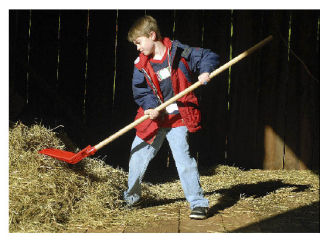In its 120-plus years, the Mary Olson Farm on Green River Road had seen many such mornings, crisp and clean and cool, golds and reds crowning the trees in the orchard and woods with autumn glory.
But last week something wandered in that would have floored the Olsons – a gaggle of fidgety first-graders from Angelica Howell’s and Kelli Johnson’s classes at Alpac Elementary School, there to soak up the curiosities of a curious place from a bench under an apple tree.
“The bees come to visit, flying from blossom to blossom. They visit every apple tree for miles around,” said Erin McEntire, educational assistant at the White River Valley Museum. “So why do they hang around in the fall?”
A small hand shot up.
“Maybe they love apples,” a boy ventured.
Before the lesson ended, McEntire invited each student to step forward to an antique cider press, crank the machinery and sip the squeezings.
“Angie and Carolina, come on up and give yourselves a turn,” said McEntire. “One, two …”
“Juice is coming out!” a boy yelled.
So it goes every day, yellow buses spilling their bounty of little ones primed to plumb the mysteries of a farm coming to life again under the guiding hand of the White River Valley Museum and the City of Auburn.
Since school opened, a collaboration between the Auburn School District and the museum has offered every first-grader a chance to take the 90-minute tour. Auburn Rotary sponsors the programs.
Tara McCauley, curator of education at the White River Valley Museum, said the first-graders’ tour centers on two questions: what kinds of foods come from a farm; and how are those foods connected to what people actually eat.
To explore these ideas, the students, averaging 60 at a time, are broken into four groups and spend 20 minutes at four learning stations. At the barn, they practice barn chores and churn butter, at the orchard they press cider, at the garden they till the soil with hoes and spades and plant a seed to take home.
And at the chicken coop, over a squawking, feathered chorus, they learn how to feed the birds, how to gather eggs and how to tell a rooster from a hen.
So far 1,500 kids, 26 tours in all, have made the pilgrimage.
The museum piloted the program last year with Dick Scobee, Lea Hill and Terminal Park elementary schools.
“Once we looked around and realized the restoration of the buildings and landscape was far enough along that it was safe for little people to be on-site,” McCauley said, “we set to work developing programs. We worked very closely with the school district from day one, creating an advisory committee with teachers and administrators to help develop the programs and guide the project. We spent about one year developing both the pre-visit notebook and the on-site activities. These types of programs have always been part of the long-term vision of the Farm – utilizing its potential as an outdoor classroom.”
McCauley, McEntire, and a team of 22 highly trained and capable volunteer tour guides make up the farm education team. Volunteers attend about 15 hours of training throughout the year in preparation for these programs. There are four to six on site for each tour.
Donna Reiss, well versed in all things chicken, is one of these tour guides. The teachers themselves are provided with a pre-visit notebook with books, music CDs, a DVD and six lesson plans on farms and farming.
“If the farmer could see the shadow of a baby-chicken growing in there, he would put this egg back in the nest, and the hen would sit on it 21 days and the baby would hatch,” Reiss told the kids gathered around her. “If he saw just the round shadow, that was the egg yolk, he would take it to the store and sell it.”
Sometimes quality learning like that spills over into more seasoned ears.
“I didn’t know that,” parent Kerry Ashby whispered as her son, Trenton, eyeballed some eggs.
From his post in the garden, Dick Ode explained his teaching methodology.
“I kind of lead off with this is a farm and all that, and why do we have a farm and how do we get food and all that, and why don’t the farmers just get in their car and drive down to the store and buy what they want,” Ode said. “Once in a while, somebody will pop up and say, ‘They didn’t have cars.’ Most of the time they don’t even think of that aspect.
“I use that as a way to get them thinking that this is an old, old farm, and it was way before cars. The tours are a very good experience for them, and they are very receptive,” Ode said.
Sara Clawes, 6, liked everything about the tour, especially digging for potatoes and sampling cider.
But she had 10 small complaints.
“My piggies are cold,” Clawes said, pointing to her feet.


